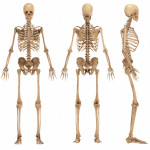Two annual doses of Reclast (zoledronate) improved bone health for up five years in a small study involving HIV-positive people with bone mineral deficiency, according to a study to be published by New Zealand researchers in the June issue of The Journal of Clinical Endocrinology & Metabolism (JCEM).
Bone mineral loss—known as osteopenia when it is mild to moderate and osteoporosis when it is more severe—is a disorder that most commonly strikes women after they’ve gone through menopause, people with thyroid problems and people who’ve taken corticosteroids for many years. There have been increasing reports in recent years, however, of younger HIV-positive women and men with bone mineral loss. Unfortunately, few studies have looked at osteopenia and osteoporosis treatments in people living with HIV.
To explore the potential of zoledronate, which has been approved as an annual injection for women with osteopenia and osteoporosis in the United States, Mark Bolland, MBChB, of the department of medicine at the University of Auckland in New Zealand and his colleagues initially conducted a two-year study involving 43 men living with HIV. The study volunteers took vitamin D and calcium supplements plus annual 15-minute intravenous infusions of either Reclast or placebo for two years.
The study’s original two-year results were published in April 2007 in JCEM. The more recent results focus on a four-year extension period in which the researchers assessed the long-term effects of Reclast administration during the original study.
Upon entering the trial, the men averaged 49 years of age, had been living with HIV for about eight years and were all on antiretroviral therapy. The average bone mineral density (BMD) T-score was -0.5—a half standard deviation below the average for a healthy 30-year-old adult of the same sex and ethnicity—which reflects relatively mild amounts of bone loss in this group of study volunteers.
In brief, at the end of the original two-year follow-up point, BMD of the spine increased 8.9 percent in the Reclast group (compared with 2.6 percent in the placebo group); BMD of the hip increased 3.8 percent compared with a 0.8 percent decrease; and total body BMD increased by 2.3 percent compared with a 0.5 percent decrease in the two groups, respectively.
Of the original 43 men, 31 received both annual injections and reported for follow-up for an additional four years—technically five years after they received their second dose.
At the end of the follow-up period, or six years after entering the study, participants’ measurements for spine, hip and total body BMD remained 3.5, 3.4 and 1.6 percent higher among those treated with Reclast compared with placebo.
Bolland and his colleagues also noted that blood levels of osteocalcin and beta-C-terminal telopeptide of type I collagen (CTX) remained significantly lower—38 and 49 percent, respectively—at the end of the follow-up period among those treated with Reclast compared with placebo. Both osteocalcin and CTX are biochemical markers for the bone breakdown and formation process. Studies have demonstrated that elevations in these markers are relatively well correlated with bone diseases characterized by increased bone turnover, especially osteopenia and osteoporosis.
While the study wasn’t designed to compare bone fracture rates between the two groups—the ultimate goal of treatment with medications like Reclast is to reduce the risk of serious fractures—Bolland and his colleagues noted that two fractures occurred during the follow-up period. Both fractures were among patients who received placebo infusions during the main two-year study.
Reclast was generally well-tolerated during the original two-year follow-up period, with no differences between those who received active drug or placebo during the extension period.
“The effects of two annual doses of zoledronate in men persist for at least five years after the second dose,” Bolland and his colleagues conclude. “Larger trials assessing the anti-fracture efficacy of less frequent dosing of zoledronate are justified.”
Advertisement
Advertisement
Advertisement






Comments
Comments